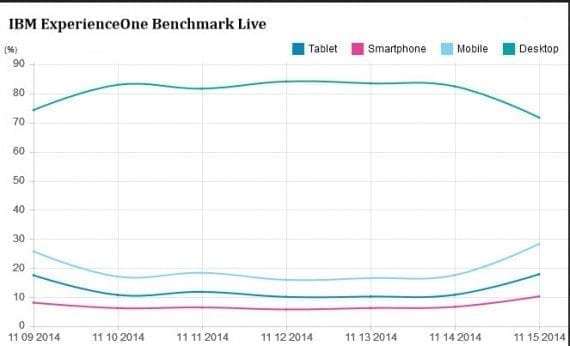Mobile commerce will boom this holiday season, email will work better, and IBM intends to prove it with real-time online shopping trends data free to anyone.
IBM’s ExperienceOne Benchmark Live online shopping trend tool shows real-time and historical data about U.S. online sales, site traffic, average order value, ecommerce conversion rates, bounce rate, and shopping cart abandonment. The tool will also track trends in real time for online sales Thanksgiving Day, Black Friday, and Cyber Monday.
The ExperienceOne Benchmark Live was clearly created to promote IBM’s ExperienceOne customer management solution; it is important to understand that when one views the data. Nonetheless, the information provided is fascinating, especially given that the tool “analyzes hundreds of terabytes of real-time shopping across participating U.S. websites” and outputs results based on 370 performance indicators.

IBM’s Benchmark Live tool tracks broad, U.S. retail ecommerce trends.
Benchmark Data
As the Benchmark Live service’s name implies, this data is likely to be most useful to ecommerce businesses — particularly small and mid-sized ecommerce businesses — as a way of benchmarking against much larger online sellers for the purpose of identifying trends in customer behavior.
As an example, the chart below was taken from the Benchmark Live site. It shows online sales by day for Nov. 9, 2014 to Nov. 15, 2014. Notice that on both the 9th and the 15th overall mobile purchases rose to nearly 30 percent of online sales. Indicating that shoppers are more likely to shop from a mobile device on the weekends.

This graph of online sales shows that shoppers seem more likely to use mobile devices on weekends.
This may lead some small and mid-sized online sellers to aim additional advertising and promotion at mobile users on Saturdays and Sundays, or, conversely, refocus on desktop users during business days.
What’s more, this data may indicate that at least some shoppers are making purchases during the workday, perhaps from a work computer. An online seller could make shopping easier in that environment, perhaps.
This sort of trend data leads to just these kinds of questions, which in turn give ecommerce business owners and marketers an opportunity to find ways to better serve customers and ultimately make more sales.
Data Driven Predictions
The Benchmark Live data comes from several internal sources, including ExperienceOne and Silverpop, an email and customer engagement solution that IBM acquired in May 2014.
Overall, IBM is projecting a 15-percent increase in U.S. retail ecommerce sales during the five days from Thanksgiving Day through Cyber Monday.
Massive Mobile Growth
According to IBM, “mobile browsing is expected to account for 48.2 percent of all online traffic over the five-day period [from Thanksgiving to Cyber Monday], an increase of 23 percent over last year. Mobile sales are also expected to rise, accounting for 24.4 percent of all online sales, up 9.5 percent year-over-year. Apple’s dominance in mobile shopping experiences is also expected to continue with iOS device traffic projected to double that of Android devices, and sales expected to quadruple.”
Mobile shopping may also become the “new Thanksgiving tradition,” again according to IBM, with approximately 53 percent of all Thanksgiving Day ecommerce purchases originating from a mobile device.
Tablets vs. Smartphones
While overall mobile commerce is on the rise, shoppers clearly use different classes of mobile devices for different shopping-relating tasks.
IBM estimated that some 29 percent of all U.S. online traffic would come from smartphones during the shopping period from Thanksgiving Day through Cyber Monday, while tablet users would account for about 15 percent of traffic during the same period. “However, IBM predicts tablets will account for twice as many mobile purchases than smartphones, thanks to the larger screen size.”
This is not a new trend, but it is a significant reinforcement of what many ecommerce marketers already understand. This sort of data should have implications for how companies optimize websites.
Expect More Digital Coupons
Citing familiarity with digital coupons and the entering digital coupon codes, IBM predicted that consumers would be more likely to use coupons and presumably seek out coupons. If this is in fact true, it may mean that online retailers could benefit from publishing and distributing online coupons.
Digital coupons could be distributed via coupon sites like RetailMeNot, via online display advertising, as video pre-roll on YouTube, or as an audio ad on Pandora.
Email Will Be More Effective
Online retail marketers, particular at relatively large enterprises, have become very good at segmenting email lists and delivering much more relevant messages. This, in turn, means email click-through rates should be up about 10-percent versus last year, according to IBM.
Small and mid-sized online retailer marketers could use this prediction to motivate more careful list segmentation. The aim is not to send the same message to everyone on your email list, but rather to send messages that will be meaningful and relevant to the recipient. These more meaningful email messages will tend to enjoy better click-through rates and, ultimately, more conversions.




